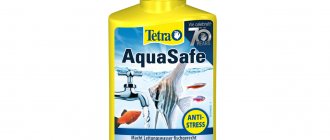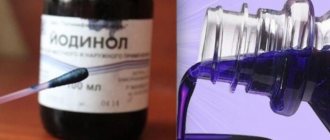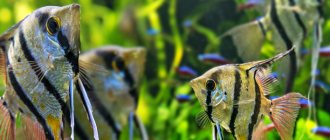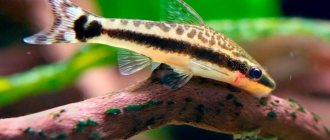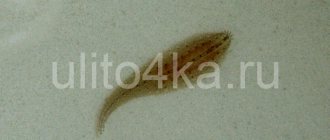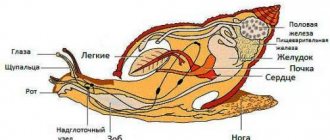Medicine for fish Baktopur is a product that is produced in liquid form. It is used to eliminate external symptoms of infections. The drug is effective against rotting fins and mouth, ulcers, flat cloudy plaque on the scales, clouding of the eyes and other infectious pathologies. Sera Baktopur is active against wounded fish. The product is highly effective and safe.
Sera Baktopur - a drug for the treatment of external diseases of aquarium fish
Pharmacological properties
"Baktopur" is a high-quality German medicinal product, which is designed to treat ornamental pet fish and is used in freshwater aquariums.
The active components have an antibacterial effect and destroy most known bacteria, including Aeromonas and Pseudomonas. The product disinfects aquarium water and has an antiseptic effect on fish.
Acriflavine is a low-toxic substance that limits the growth of not only harmful bacteria, but also algae, fungi or mold.
Methylene blue is an antiseptic dye that reacts to most bacteria and mycoses, destroying harmful organisms.
How to use?
The instructions for using Baktopur are quite simple. It is in every box of medicine, and in several languages. But for those who want to familiarize themselves with the treatment method with this drug in advance, we will tell you in detail:
- Before you start using the medicine, you need to shake it well.
- Remember, for every 20 liters of water we use 1 ml of the drug. You count out 22 drops, this is the required dosage.
- On the first day, the medicine is introduced into the aquarium.
- There is no need to use it on the second day.
- On the third day, the treatment is repeated in the volumes stated above.
- In especially severe cases, Baktopur is added to the aquarium water on the 5th and 7th days.
From the editor: Rasbora cuneiformis
After completion of treatment, a water change is carried out in a volume of 50% of the total.
Indications for use
The drug is an antibacterial agent that is designed to fight most types of bacteria in freshwater aquarium fish. Suitable for the treatment of columnar blight, gill and fin rot, as well as typical bacterial diseases.
Bacterial infections of fish can manifest themselves in the form of whitish or grayish spots on the body and fins. The edges of the fins may be inflamed. Swelling and inflamed areas appear on the skin of scaly pets. Bleeding from the anus may also occur.
Infectious diseases of fish can be accompanied by bloating and dropsy, when the cavity inside the body is filled with watery fluid. At the same time, small pets’ eyes often bulge, and their scales begin to become very puffy.
You may also notice bruising on the skin and cotton-like fuzz around the mouth, and greyish-whitish pustules appearing on the fins and scales. Fins can sometimes be completely destroyed by infection.
Fin rot
We talk about medicine, but we avoid mentioning diseases, and this is wrong. Readers should be able to distinguish the appearance of a particular disease by external signs.
Let's start our story with one of the most common diseases among aquarium inhabitants. It is called fin rot, and “Sulfur Baktopur” successfully copes with the symptoms of this disease.
From the editor: Hardscape - our aquarium everything
What is fin rot? A bluish-white coating appears on the edges of the tail and fins. The ends of the fins look like they have been plucked off. And if the spread of the disease is not prevented, it will cover the entire body of the fish.
Sometimes you can see red stripes or spots appear on the fins. This is a type of rot, then these stripes will turn into ulcers.
A characteristic feature of the disease is clouding of the eyeballs in fish.
Mode of application
"Baktopur" can be used in two ways - in a general aquarium or in a fish tank.
To use the drug in a general aquarium, the product is first diluted in 200-300 milliliters of settled water, after which the resulting solution is added to the contents of the aquarium, distributing it evenly throughout the entire volume.
In a general aquarium, treatment is carried out according to the following scheme:
- Day 1 - administration of the first dose of medication;
- Day 2 - no treatment is carried out, we do not give medicine, we only feed the fish;
- Day 3 - do a 30% water change and add medicine;
- Day 4 - no treatment.
And so we continue until the fish are completely recovered. The medicine is added to the aquarium water every other day and only after changing 30% of the water.
It is recommended to turn off the light in the aquarium immediately when adding the medicine. During treatment, aeration should be maximized, and cleaning of the filter from sorbents should be frequent and of high quality, but the use of activated carbon is unacceptable.
For treatment in a septic tank, the solution is prepared in a glass container, where the amount of water is selected individually, but the ratio of medicine to water should remain unchanged - 1 milliliter per 20 liters of water.
After preparing the mixture, its temperature is brought to the same level as the temperature of the water in the aquarium. After this, the sick fish are transplanted into a container. Enhanced aeration is also necessary in this case.
The duration and frequency of procedures are determined according to indications.
Method of using "Baktopur": video
Storage conditions
The drug should only be stored at room temperature within the range of 15 to 25°C. Storage is permissible only in a dark place inaccessible to children.
Be sure to make sure that the bottle of medicine must be carefully closed to prevent weathering and evaporation of the active ingredients.
Find out what the drugs are used for: Kostapur, Antipar.
Side effects
In most cases, the drug "Baktopur" does not have side effects that affect the health of the fish, since it is a fairly gentle remedy. However, it is not always effective and can only cope with mild infections.
If the drug has positive dynamics, then the condition of the fish after treatment improves after the first or second dose of the drug. But if even after repeated use there is no improvement in the condition of the fish, then it makes sense to turn to another, stronger remedy.
Among the side effects, one can highlight the fact that Baktopur tends to worsen filtration in the aquarium, however, still not as much as other similar drugs. It also colors aquarium water in a yellowish-green tint, and the coloring of polyurethane and silicone decoration elements is permanent and no longer washes out.
The main disadvantage of the drug is its ineffectiveness against serious bacterial infections.
In addition, the medicine negatively affects aquarium vegetation, inhibiting its growth and destroying nitrifying bacteria.
After completing treatment, it is recommended to perform a water change and use activated carbon to completely clear the water of the medicine.
At times, Baktopur can cause increased skin sensitivity in fish to ultraviolet radiation, so it is recommended to keep the aquarium away from sunlight during the treatment period.
Dropsy
This disease affects not only people and animals, but also fish.
It is not always contagious to the rest of the aquarium inhabitants if it is found in one of them. But it’s not worth the risk; it is advisable to place the patient in a separate tank, and clean the main aquarium for preventive purposes, change the water and rinse the equipment. The “patient” is treated with “Sera Baktopur”. The main signs of dropsy:
- The fish has a swollen belly, just do not confuse the disease with banal overfeeding or pregnancy.
- The aquarium inhabitant has rapid breathing, which can be seen by the unnatural swelling of the gills.
- A sick fish is lethargic, it stays on the surface of the water, closer to the back wall, avoiding contact with other aquarium inhabitants. Her fins are down.
- The fish refuses to eat; if you see its excrement, it is slimy.
- The color becomes cloudy and the brightness disappears.
- The scales are raised, stick out unnaturally, and the body of the underwater inhabitant looks very round, because it is bloated.
Contraindications
“Baktopur” has practically no contraindications, however, it is not recommended for beginner aquarists to use the product in new aquariums where biological balance has not yet been established and the microflora has not been stabilized. Otherwise, the drug can completely destroy the rudiments of microflora and provoke the death of plants and fish. This means that the drug should not be added to a new aquarium for the purpose of prevention.
If there is a need to use the drug in a new aquarium, it is better to use a fish tank. In the presence of serious infectious diseases, the use of the drug “Baktopur” is also pointless, because it can only cope with mild infections. However, the medicine can be effective when used at the initial stage of the disease and when the first symptoms appear. If the disease has been running for a long time, then it is better to immediately turn to stronger antibacterial drugs.
In rare cases, Baktopur may not be suitable for certain types of fish that are hypersensitive to the drug - for example, catfish.
It is unacceptable to use the medicine with other medications from other manufacturers, as they do not combine. But use in combination with any other drugs from the manufacturer Sera is welcome.
Lepidorthosis
The second name for this disease is ruffled scales. The most susceptible to it are very young individuals, as well as fish that have not undergone quarantine after acquisition. Not only will they catch the infection themselves, but they will also infect the entire aquarium.
If you do not intervene in time with treatment, then sick fish are doomed to death. Therefore, as soon as the owner notices signs of the onset of the disease, he urgently goes to the store, buys “Sera Baktopur”, and begins a course of treatment.
What symptoms visible to the human eye indicate a disease? These include:
- First, scales rise in some places on the fish’s body. The aquarium resident herself becomes restless, she rubs herself against the stones and soil, because the itching is very annoying.
- The disease progresses slowly, the more severe its form, the more scales fall out. Ultimately, it almost completely dies off, the fish lose their bodily covering and die.
Analogs
In addition to Baktopur, Sera also offers a similar analogue, Omnipur. But this manufacturer is not the only one who makes medicines for mild bacterial aquarium infections.
Medicines such as:
- “GeneralTonic” from Tetra Medica (Germany) not only fights fungi and bacteria, but also heals wounds;
- MelaFix and T.S. Capsules" from Aquarium Pharmaceuticals (USA). The first drug, in addition to its antibacterial effect, also effectively heals wounds, and the second is a very mild antibiotic;
- Acriflavine and methylene blue are produced as separate active ingredients, available in production from different class=”aligncenter” width=”840″ height=”470″[/img]
- “Biseptol-480” and “Bitsillin-5” are produced as pharmaceutical products and are available for purchase at the pharmacy, but the first product is poorly soluble in water and therefore requires increased aeration, and the second has a detrimental effect on the plant flora of the aquarium;
- “Antibak” from the Scientific and Exhibition Center “Agrovetzashchita” (Russia) - helps not only with ordinary bacterial infections, but also with mixed bacterial-protozoal diseases;
- “Akrimet” from LLC “Zoomir” (Russia) - similar to “Baktopur”, but, among other components, it also contains malachite green and is used only in sediment tanks;
- Purple “K” is produced by several companies in Russia - it is suitable for fighting fungi, bacteria and protozoa.
Despite the large number of similar drugs, Baktopur has proven its effectiveness against mild forms of infections in aquarium fish. It effectively copes with its task in the first stages of the disease, preventing the initial stage from developing into complications. The drug has virtually no contraindications and is well tolerated by most species of ornamental fish.
Composition and characteristics of the product
100 ml of the drug contains the following components:
- acriflavine - 209.7 mg;
- methylene blue - 4.95 mg;
- phenylglycol - 0.6 g;
- purified water.
It is not advisable to use the product on fish that are eaten. It is allowed to be used in purified small reservoirs.
The drug should be stored out of the reach of small children; it is important to monitor the expiration date. It cannot be used in conjunction with similar drugs. This may lead to an overdose.
The bottle can be used as a pipette to add the product.


